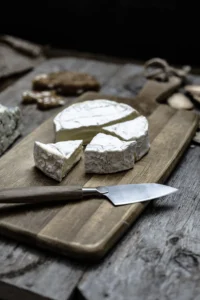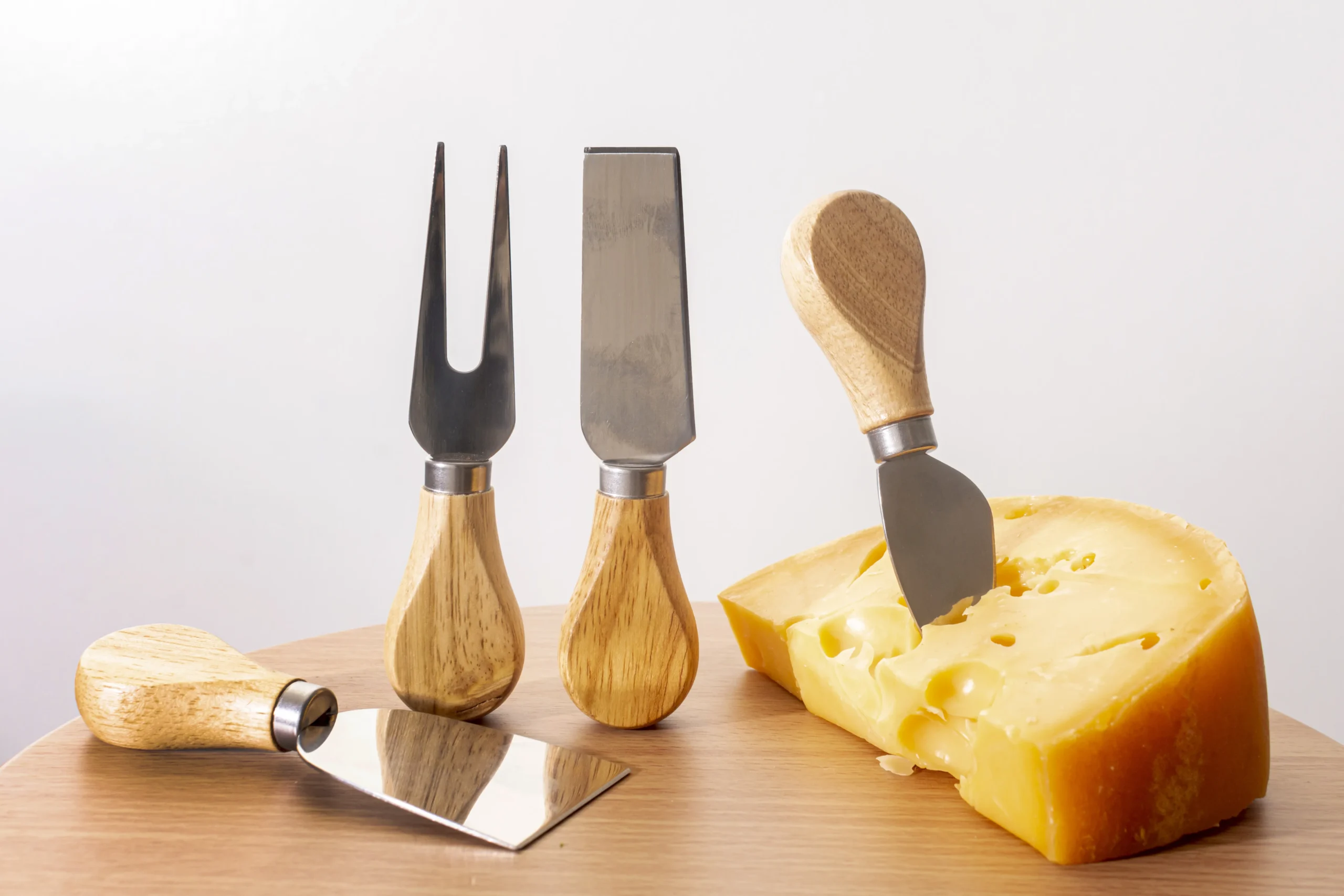Table of Contents
ToggleTypes of Cheese Knives

Different cheeses demand specific tools for the best results. Cheese knives come in a variety of designs, each tailored to cut and serve a specific type of cheese. Below are the main types of cheese knives, along with their uses and advantages:
Soft Cheese Knives
These knives are specifically designed to handle soft and creamy cheeses like Brie, Camembert, and triple cream varieties. The blades typically feature perforations or holes that reduce surface contact, preventing the cheese from sticking. This ensures clean cuts without distorting the cheese’s delicate texture. For best results, pair soft cheeses with a knife that has a thin, sharp blade.
Hard Cheese Knives
Thick and robust, these knives are essential for cutting through aged cheeses like Parmesan, Pecorino, and mature Cheddar. Hard cheese knives often feature a chisel-like edge that allows you to break chunks off hard cheese wheels. This design is particularly useful for serving hard cheeses in their authentic rustic form.
Universal Cheese Knives
As the name suggests, these knives are versatile and can handle a range of cheese types, from semi-soft to semi-hard. They are a great option for cheese lovers who enjoy a variety of textures on their platters but don’t want to invest in multiple knives.
Specialized Cheese Knives
- Fork-Tipped Knives: These are perfect for serving cheese slices after cutting. The forked tip lets you easily transfer slices to a plate or platter without touching the cheese.
- Spreaders: Ideal for spreading soft and creamy cheeses like goat cheese or herb-infused cheese spreads. These knives are designed with a wide, flat blade that makes spreading effortless.
- Wire Cutters: Best for crumbly cheeses like Blue Cheese or Feta. The wire ensures clean cuts without crushing the cheese or creating a mess.
For recipes that beautifully pair with cheeses, you can explore goat cheese appetizers. These dishes are perfect for showcasing your cheese knife skills.
Materials Used in Cheese Knives
The construction of your cheese knife has a significant impact on its functionality, durability, and ease of maintenance. Selecting the right materials ensures you get a knife that meets your needs while lasting for years.
- Blades
- Stainless Steel: This is the most popular choice for cheese knives due to its rust resistance and durability. Stainless steel blades are low maintenance and remain sharp over time, making them ideal for frequent use.
- Carbon Steel: Known for its superior sharpness, carbon steel blades are perfect for precision cutting. However, they require more care as they can rust if not properly cleaned and dried after use.
- Handles
- Wooden Handles: These offer an elegant and traditional look but require hand washing and regular care to prevent damage. Wooden handles are often paired with high-end cheese knives.
- Composite or Plastic Handles: Durable and often dishwasher safe, these handles are practical for everyday use. They come in various colors and designs to match any kitchen aesthetic.
Discover more about pairing cheeses with other ingredients by exploring this ultimate guide to Colby Jack cheese. It’s a fantastic resource for combining cheese flavors with complementary dishes.
How to Use a Cheese Knife Properly
Using a cheese knife effectively involves more than just cutting—it’s about preserving the cheese’s texture, flavor, and visual appeal. Proper slicing techniques ensure that the cheese retains its integrity, making your presentation both appealing and functional.
- Slicing Techniques
- For soft cheeses, use a gentle rocking motion to prevent squishing. This minimizes pressure on the cheese and ensures smooth cuts.
- For hard cheeses, apply firm, steady pressure and slice at an angle to achieve clean edges. Chisel-style knives are particularly effective for creating rustic chunks.
- For crumbly cheeses, use a wire cutter to maintain the cheese’s natural shape and prevent crumbling.
- Presentation Matters
When arranging your cheese platter, use each knife for its designated cheese type. This prevents flavor mixing and ensures your cheese board looks professional. Pair your knives with complementary tools like spreaders and forks for a complete presentation. For inspiration on cheese board pairings, check out this comprehensive guide to American cheese.
Maintenance and Care for Cheese Knives
Proper care extends the life of your cheese knives and ensures they perform well every time you use them. Neglecting maintenance can lead to dull blades, rust, and reduced functionality.
- Cleaning Tips
Hand wash cheese knives immediately after use, especially those with wooden handles. Use warm, soapy water and a soft sponge to remove cheese residue. Avoid using abrasive materials that can scratch or dull the blade. - Sharpening
Regularly sharpen your cheese knives to maintain their cutting edge. Use a honing steel or a knife sharpener specifically designed for fine blades. If you’re unsure how to sharpen your knives, consider having them professionally serviced. - Storage Suggestions
Proper storage prevents damage to the blades and ensures safety in the kitchen. Use knife blocks, magnetic strips, or individual sheaths to keep your cheese knives in top condition.
FAQs About Cheese Knives
Why do some cheese knives have holes in the blade?
The holes reduce surface contact between the blade and the cheese, preventing soft cheeses from sticking. This design feature ensures smooth cuts and maintains the cheese’s texture.
What’s the purpose of a forked tip?
The forked tip helps you serve neatly sliced portions of cheese. It eliminates the need for additional serving utensils, making your cheese platter presentation more efficient.
Can I use a regular knife?
While a regular knife can cut cheese, a cheese knife is specifically designed to preserve the cheese’s flavor, texture, and appearance. Using the right knife ensures a superior cheese-tasting experience.
Are cheese knives dishwasher safe?
Some cheese knives with plastic or composite handles are dishwasher safe. However, knives with wooden handles or carbon steel blades should be hand washed to prevent damage.
Final Thoughts
Elevate your cheese experiences by investing in the right tools and techniques. By understanding the different types of cheese knives, their materials, and proper usage, you can enjoy better flavors and textures while impressing your guests with beautiful presentations. Use this guide to confidently select and maintain your cheese knives, making every cheese board an unforgettable culinary delight.


2 thoughts on “Choosing and Using a Cheese Knife”